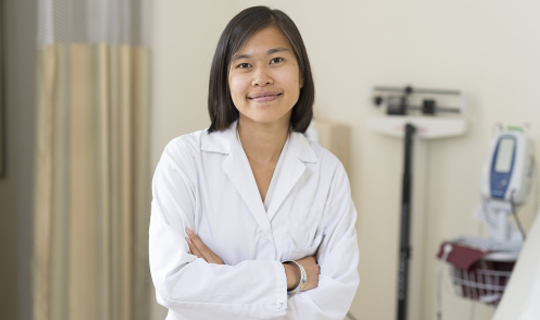
Rachelle Leong, MD is a fellowship-trained physician specializing in breast surgery at Clara Maass Medical Center and is also a member of the premier medical staff of Barnabas Health Medical Group (BHMG), a multispecialty practice affiliated with RWJBarnabas Health
One in eight women will develop invasive breast cancer in their lifetime, making it the most commonly diagnosed cancer in women. While fatality rates are decreasing – a fact which is largely attributed to secondary treatment advances – earlier detection through screening increases awareness.
Finding breast cancer early is the main goal of routine breast care and maintaining good breast health. That's why it's so important to follow your doctor’s plan for preventive care. Finding problems early gives you the best chance of successful treatment. But when should you start breast screenings – particularly mammography screenings? As a breast surgeon at Clara Maas Medical Center, I recommend beginning bilateral screening mammograms annually beginning at age 40. As your age increases, the incidence of breast cancer increases and mammograms are considered the gold standard for screening for breast cancer. However, in addition to mammograms, there are a number of different ways that you can get screened for breast cancer. The types of breast cancer screening include:
- Physical exams by your doctors
- Mammography – X-rays used to create images of the breast
- Ultrasound – used for patients with dense breasts that, in addition to mammograms, allow doctors to look for additional masses, abscesses, and cysts
- MRI – primarily used in newly diagnosed breast cancer patients for staging and planning, not currently recommended for screening average risk patients. It is mainly used for patients that are deemed high risk (genetic mutations, significant family history, etc.)
It is important to note that all things that can be found in the breasts during a screening are not cancer. Routine care can also help find other non-cancerous or benign conditions, too. There are many signs and symptoms that women associate with breast cancer but are, in fact, something different. For example, fibroadenomas, which are benign, solid but mobile masses, can be found in the breasts. Signs and symptoms of fibroadenomas include:
- tenderness and size variation according to cycle
- younger age at onset
- detection on ultrasound or clinical breast exam
- decrease in size with age
If a fibroadenoma is suspected, doctors may perform a biopsy. If the biopsy confirms the presence of a fibroadenoma, women are encouraged to get follow-up ultrasounds every six months for two years to ensure stability. Fibroadenomas that are larger than three centimeters or grow larger over time may be an indication for removal. To be clear, there is no risk of fibroadenoma turning into cancer; they are benign but it’s important to talk to your health provider and follow their recommendations for screenings.
Another common occurrence that can alarm women is breast pain. While breast pain is a very common complaint, it is not a sign of breast cancer. Breast pain can be unilateral or bilateral, can occur in both pre-menopausal and post-menopausal women, and can be cyclical or non-cyclical (align with the menstrual cycle or not). Cyclical breast pain:
- tends to be more common and usually occurs about five days prior to the start of your period
- usually starts in the upper outer area of the breasts
- is resolved in 42% of women when they get to menopause
On the other hand, non-cyclical mastalgia (breast pain):
- is less frequent than cyclical
- has a shorter duration of symptoms
- usually affects one side and 50% of the pain will spontaneously resolve
To treat breast pain, I recommend warm compresses, a well-fitting bra, taking NSAIDS or Tylenol, vitamin E, and evening primrose oil. There is some limited data that suggests the elimination of caffeine may work for breast pain, but this is something that should be decided on an individual, patient by patient basis.
Statistically, earlier presentation of breast cancer increases the chance of survival, so early detection has a direct effect on the outcome and prognosis. Clara Maass Medical Center offers patients the latest aid in early breast cancer detection – digital mammography. A digital mammogram uses a special detector to capture and convert x-ray energy into a digital image, rather than capturing it on film. With the growing number of breast cancer diagnoses each year, the advantages of digital imaging are more important today than ever before. Digital mammography is now the preferred method of viewing and evaluating mammograms and offer results sooner since images are available immediately. Additional benefits include faster results, clearer and better-quality images, increased patient comfort and the ability to easily store and retrieve images.
Setting Clara Maass Medical Center apart from other facilities in early breast cancer detection is the Upright Stereotactic Biopsy, which provides a more comfortable biopsy experience for the patient, given suspicious tissue findings. The stereotactic approach to biopsying reduces pain, scars, recovery time and the risk of postsurgical complications. The upright approach also provides more comfort to the arms and neck in addition to positioning the breast in the same manner as when the area of concern was detected.
Talk to your doctor about your risk factors for breast cancer and to identify which prevention and screening plan is best for you based on your individual health care needs. To learn more about breast health or to schedule an appointment with Dr. Leong, please call 973-844-4161 or visit www.rwjbh.org/Leong.
At RWJBarnabas Health, we care for more patients with breast cancer than anyone in New Jersey. We offer the best in breast cancer treatment, including state-of-the art technology, the latest diagnostic services, breast health information, and a multidisciplinary team of specialists to facilitate evaluation, coordinated treatment, and follow-up care.